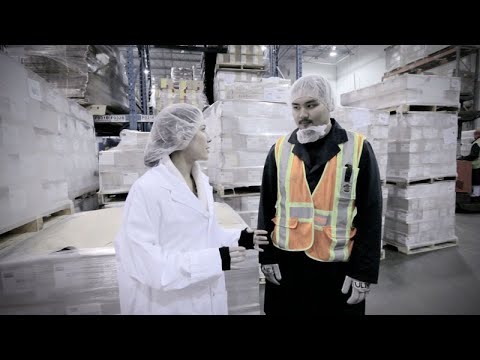Career Overview
Shippers and receivers ship, receive and record the movement of parts, supplies, materials, equipment and stock to and from an establishment.
People in this occupation work for:
- The public sector
- Retail and wholesale companies
- Manufacturing companies
- Commercial and industrial organization
Job Titles
Duties
Shippers and receivers:
- Determine method of shipment and arrange shipping
- Prepare bills of lading, customs forms, invoices and other shipping documents manually or by computer
- Assemble containers and crates, record contents manually or in a computer system, pack goods to be shipped and affix identifying information and shipping instructions
- Oversee loading and unloading of goods from trucks or other conveyances
- Inspect and verify incoming goods against invoices or other documents, record shortages and reject damaged goods
- Unpack, code and route goods to appropriate storage areas
- Maintain internal, manual or computerized record-keeping systems
- Operate forklift, hand truck or other equipment to load, unload, transport and store goods
Earnings
Earnings is income that workers receive in exchange for their labour. Depending on the type of employment, earnings can be in the form of wages (hourly), salaries (fixed monthly or annual) or self-employed earnings.
Work Environment
# Workers Employed
12,510% Employed Full Time
61%Key aspects of the work in this occupation:
- Work takes place in a conventional controlled environment such as an office, hospital or school
- Some work may be done in an outdoor work environment where the worker is exposed to variations in weather conditions and seasonal weather patterns
Career Pathways
Progression to supervisory positions is possible with additional training or experience.
Related Careers
Occupational Interests
It’s important to understand what kinds of occupations align with your interests.
For more about occupational interests visit Skills for the Future Workforce > Characteristics.
Here are the top occupational interest(s) for this career profile:
Education, Training and Skills
- Completion of secondary school is usually required
- Experience in a related clerical occupation or as a warehouse worker may be required
- A forklift certificate may be required
- A driver's licence may be required
Education programs in B.C.
The following program areas are related to this occupation:
- Academic/Basic Upgrading

Skills
Every job calls for a certain set of skills. Knowing those skills is the first step in finding a good career fit.
Here, you will find the 10 most relevant workplace skills. Some are more important to achieving success in a certain career than others. These skills may come naturally to you or you may need to gain them through education, training and experience.
See the list of work-related skills below, ranked in order of importance for this career. Check out the list and see if this career matches your skills—take that first step!
Talking to others to share information effectively.
Understanding written sentences and paragraphs in work-related documents.
Giving full attention to what other people are saying, taking time to understand the points being made, asking questions as appropriate, and not interrupting at inappropriate times.
Using logic and reasoning to identify the strengths and weaknesses of alternative solutions, conclusions or approaches to problems.
Keeping track of and assessing your performance, other individuals, or organizations to make improvements or take corrective action.
Managing one’s own time and the time of others.
Adjusting actions in relation to others' actions.
Considering the relative costs and benefits of potential actions to choose the most appropriate one.
Being aware of others’ reactions and understanding why they react as they do.
Being able to solve novel, ill-defined problems in complex, real-world settings.
Labour Market Statistics
Discover data, facts and information that have been gathered and analyzed. Learn about the characteristics of the economy and labour market in B.C.
Employment
Find out about employment types and trends by region and industry.
Employment
12,510Employment by Region







| Region | Employment | % Employment of this Occupation |
|---|---|---|
| Cariboo | 355 | 2.8% |
| Kootenay | 300 | 2.4% |
| Mainland/Southwest | 9,120 | 72.9% |
| North Coast and Nechako | 170 | 1.4% |
| Northeast | 125 | 1.0% |
| Thompson-Okanagan | 1,175 | 9.4% |
| Vancouver Island/Coast | 1,265 | 10.1% |
Labour Market Outlook
The B.C. Labour Market Outlook is a 10-year forecast of the expected supply and demand for labour in the province. It’s usually updated every year. The purpose is to provide British Columbians with the knowledge to make informed decisions on careers, skills training, education and hiring.
Forecasted Job Openings (2024-2034)
5,050Forecasted Job Openings
Forecasted Employment Growth Rate
Composition of Job Openings
Job Openings by Region (2024-2034)







| Region | Job Openings | Avg. Annual Employment Growth |
|---|---|---|
| Cariboo | 90 | -0.1% |
| Kootenay | 60 | 0.0% |
| Mainland/Southwest | 3,900 | 1.5% |
| North Coast and Nechako | 110 | 2.0% |
| Northeast | 60 | 1.0% |
| Thompson-Okanagan | 410 | 0.7% |
| Vancouver Island/Coast | 440 | 0.5% |
Industry Highlights
Learn about the opportunities in B.C.'s major industries, including employment trends, earning potential, locations of work and more.
Forecasted Job Openings by Industry
| Industry | Job Openings (2024-2034) |
|---|---|
| Retail Trade | 1,870 |
| Wholesale Trade | 1,080 |
| Manufacturing | 840 |
| Transportation and Warehousing | 590 |
| Professional, Scientific and Technical Services | 150 |
Resources
Resource information is currently not available.









